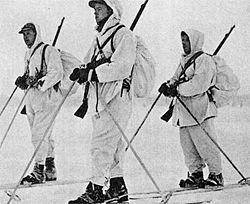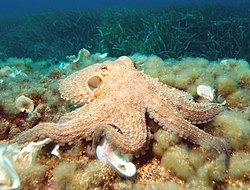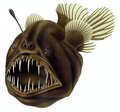Top Qs
Timeline
Chat
Perspective
List of camouflage methods
List of ways of hiding objects or animals in plain sight From Wikipedia, the free encyclopedia
Remove ads
Camouflage is the concealment of animals or objects of military interest by any combination of methods that helps them to remain unnoticed. This includes the use of high-contrast disruptive patterns as used on military uniforms, but anything that delays recognition can be used as camouflage. Camouflage involves deception, whether by looking like the background or by resembling something else, which may be plainly visible to observers.[1][2] This article lists methods used by animals and the military to escape notice.
Remove ads
Conventions used
Summarize
Perspective

Different camouflage methods employed by terrestrial, aerial, and aquatic animals, and in military usage, are compared in the table. Several methods are often combined, so for example the Bushbuck is both countershaded over its whole body, and disruptively coloured with small pale spots. Until the discovery of countershading in the 1890s, protective coloration was considered to be mainly a matter of colour matching,[3] but while this is certainly important, a variety of other methods are used to provide effective camouflage.[1][2]
When an entry is marked Dominant, that method is used widely in that environment, in most cases. For example, countershading is very common among land animals, but not for military camouflage. The dominant camouflage methods on land are countershading and disruptive coloration, supported by less frequent usage of many other methods.[4] The dominant camouflage methods in the open ocean are transparency,[5] reflection, and counterillumination.[6] Transparency and reflectivity are dominant in the top 100 metres (330 ft) of the ocean; counterillumination is dominant from 100 metres (330 ft) down to 1,000 metres (3,300 ft).[6] Most animals of the open sea use one or more of these methods.[6] Military camouflage relies predominantly on disruptive patterns,[7] though methods such as outline disruption are also used, and others have been prototyped.
In 1890 the English zoologist Edward Bagnall Poulton categorised animal colours by their uses,[8] which cover both camouflage and mimicry.[9] Poulton's categories were largely followed by Hugh Cott in 1940.[4] Relevant Poulton categories are listed in the table. Where Poulton's definition covers a method but does not name it explicitly, the category is named in parentheses.
Remove ads
Comparisons
Remove ads
References
Bibliography
Wikiwand - on
Seamless Wikipedia browsing. On steroids.
Remove ads



















































